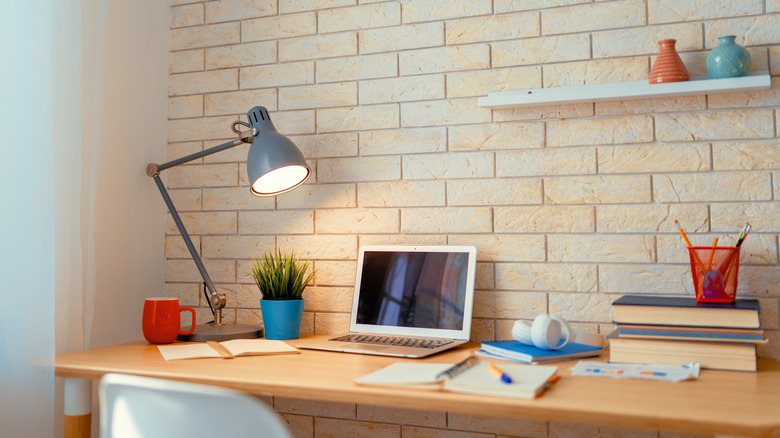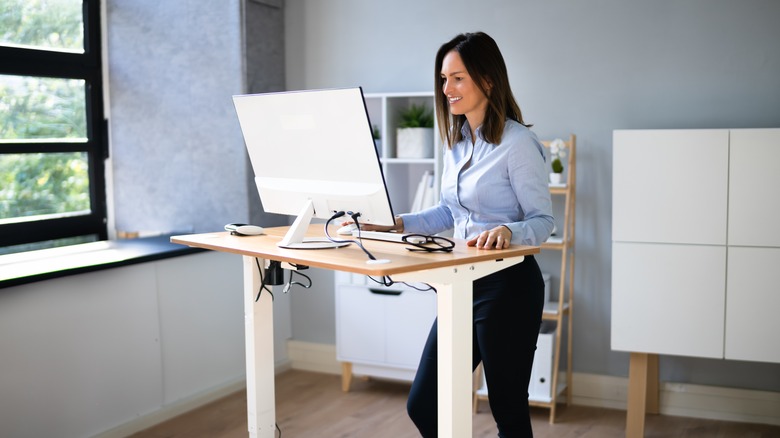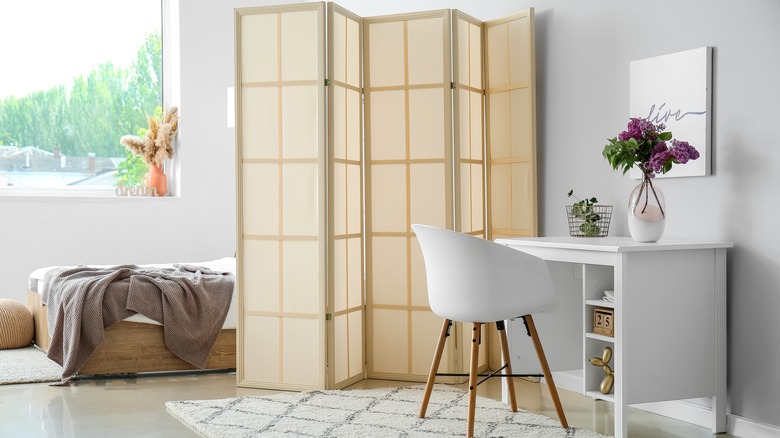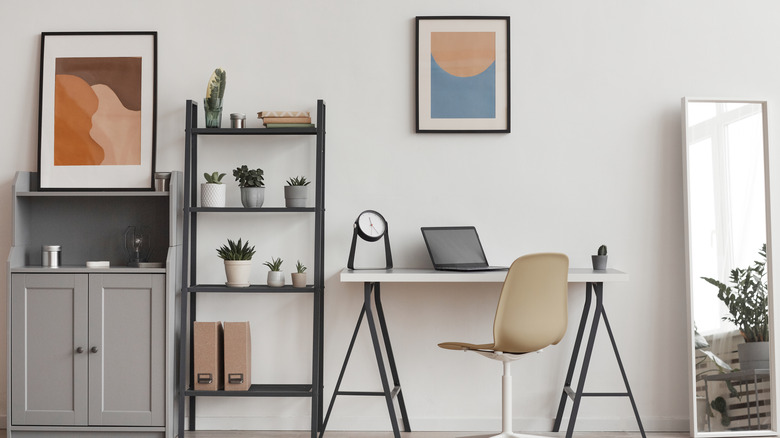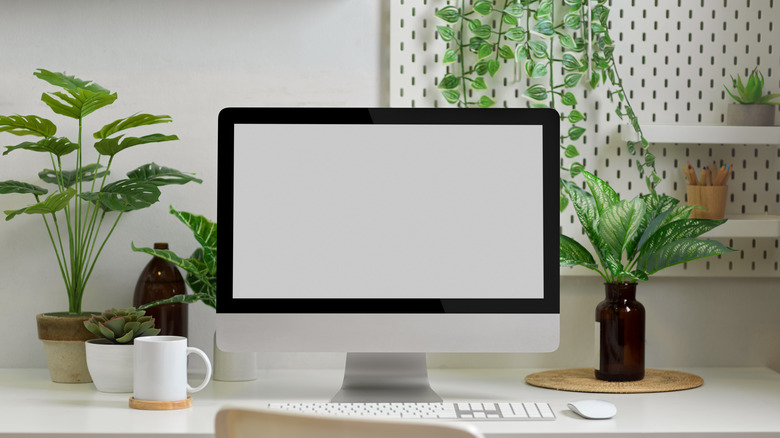Take Your Home Office To The Next Level With These 5 Savvy Upgrades
Maybe you have always worked from home, or maybe it's a recent transition. Or, maybe you don't work from, but you have a home office for your side hustle, the novel you're working on, or even just as an arts and crafts area. Whatever your home office situation, there are a number of ways you can improve your workspace to enhance productivity and focus and make work feel, well, a little less like work.
When thinking about methods of transforming your home office area, Oprah Daily recommends thinking first about what your home office needs to do for you, and then musing on ways your decor scheme can complement those needs — in other words, focusing on function first, then form. It can also help to reflect a bit on your own working style. Do you work best in a quiet, secluded space, or one where you are exposed to a lot of motion and sound to stimulate your brain? Does your job require a lot of Zoom meetings, where you may need to think about the professionalism of your virtual meeting background, or can you go a little wild with personalizing your area because no one but you will ever see it? Keeping these types of questions in mind can help you figure out what home office upgrades will work best for you.
Start with lighting
Finding the right lighting options is the first step to any office space designed for maximum productivity and enjoyment. The Homeworker recommends approaching your home office lighting choices by prioritizing three areas of focus: natural lighting, ambient lighting, and task lighting.
In a perfect world, every home office space would have natural lighting, as natural light can help counteract the strain on our eyes caused by computer screens. If you do have access to a natural light source within your home office, it is best to put your desk right next to it, so the natural light washes out the light from your screen.
If you don't have access to natural lighting, The Homeworker recommends choosing a combination of ambient lighting and task lighting. Ambient lighting is light that encompasses an entire space. It is often achieved by floor lamps and larger lighting features that bounce light off of the walls and ceiling, so that light appears to be emanating from everywhere within a room, as opposed to one single light source. Task lighting is the opposite — it focuses on the area where you complete your work tasks. Desk lamps and other smaller lighting options are good choices here, although you should use lamp shades to ensure the light isn't too harsh.
Office ergonomics
You have probably heard the word ergonomic regarding ways to improve worker health and productivity. But what exactly does it mean? As The New York Times explains, an ergonomic workspace is one that supports your body in remaining as neutral as possible. Body neutrality means your neck and spine are not twisted or tilted up or down, your arms are not overly extended, and your wrists aren't tensed up. The problem is, most home furniture is not designed with ergonomics in mind. If you have a basic desk and chair in your home office, you are probably putting more strain on your body and joints than you need to.
Thankfully, there are some simple steps to improve your home office's ergonomics. If you have the available funds, the first option is to invest in a proper standing desk, one that you can raise up and down so you can easily transition between sitting and standing. Alternatively, there are also plenty of standing desk kits and transformers that you can place on top of your desk and raise and lower so that you do not have to move the desk itself. And if you are standing for a good portion of your work day, which is recommended by health experts, you will want to make sure your feet and back are supported by using an antifatigue floor mat.
Incorporate room dividers
Not everyone has the luxury of designating an entire room as a home office area. If you live in an apartment or other smaller space where there isn't extra room to go around, you might need to come up with creative ways to separate your work area from the rest of your space. Room dividers can be a classy, cheap option to build some division between a space designed for focus and one designed for relaxation, explains CountryLiving.
Even if you are able to dedicate an entire room to your home office space, room dividers can still be a quick productivity hack. If one corner of your home office is particularly cluttery, dividing your workspace away from any disorder can help enhance your focus. If your work-from-home gig is one that involves a lot of Zoom meetings, you may be interested in a room divider to block the view of any family photos, books, posters, or other intimate details that you don't want your coworkers or clients to see.
Many room dividers do not require any sort of permanent installation, meaning you will not have to structurally alter the space you are dividing — a much cheaper and simpler way to divvy up a space than installing a new wall. If you choose to go with a portable room divider that folds up, you can even put it away entirely at the end of the workday.
Make a statement with wall art
If you have a good amount of empty wall space within your home office area, an excellent way to maximize your focus and productivity is to decorate with some wall art. Work Design Magazine reports that specific types of wall art have been proven to boost morale and reduce stress, making your workday go by faster and helping you to get more done. Nature scenes, in particular, have demonstrated a calming effect on workers. You can even swap out your wall art from time to time to keep your home office feeling fresh and new.
Wall art is also an excellent focus area for workers intent on fulfilling the 20-20-20 rule. According to the American Optometric Association (AOA), staring at a computer screen all day – as most work-from-home jobs require – can cause some serious strain on your eyes. To prevent long-term damage from screen exposure (and also reduce headaches, dizziness, and other symptoms associated with eye strain), the AOA recommends taking a break from looking at your screen every 20 minutes to stare at an object at least 20 feet away from you for at least 20 seconds (Hence the 20-20-20 rule.) Wall art is an excellent option for an object to stare at, since, as mentioned above, looking at wall art can help reduce your stress levels.
Enhance your space with houseplants
If hanging pictures of nature scenes on your home office wall is good for your mental health, imagine the benefits of actually bringing elements of nature itself into your home office space. Fortunately, that doesn't mean cultivating an entire forest: you can easily reap the benefits of nature exposure by incorporating a few houseplants. As CEO Magazine explains, bringing plants into your work area will not only improve the aesthetics but will also reduce stress and work fatigue. Consistent exposure to plants has even led to a higher immune response in some studies, so having plants in your office could help prevent you from getting sick!
So which houseplants should you go with for a mentally healthy office vibe? Healthline reports that snake plants are often cheap and easy to grow, and besides their indirect mental health benefits, they can even help purify your home office air. Another great option for your work area is a peace lily plant, which is a particularly beautiful choice for keeping on your work desk itself and may even help you to sleep better at night, according to Petal Republic. Finally, if you're nervous about your plant cultivation abilities, a hardy spider plant is an ideal choice for someone new to houseplants, explains Ferns N Petals.

